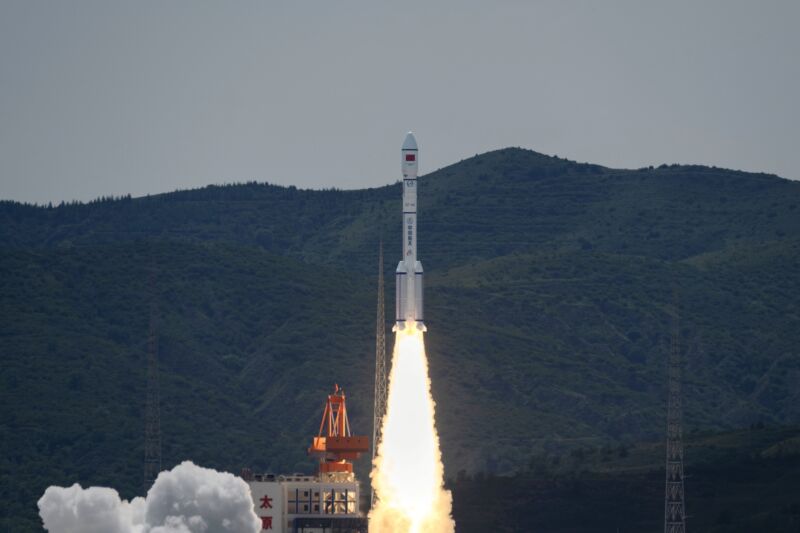
Chinese language officers have lengthy signaled their curiosity in deploying a satellite tv for pc community, or possibly a number of, to beam broadband Web indicators throughout China and different nations inside its sphere of affect.
There are two severe efforts underway in China to develop a rival to SpaceX’s Starlink community, which the Chinese language authorities has banned in its territory. The primary batch of 18 satellites for a kind of Chinese language networks launched into low-Earth orbit Tuesday.
A Lengthy March 6A rocket delivered the 18 spacecraft right into a polar orbit following liftoff at 2:42 am EDT (06:42 UTC) from the Taiyuan launch base in northern China’s Shanxi province. The Lengthy March 6A is one in every of China’s latest rockets—and the nation’s first to make use of strap-on strong rocket boosters—with the flexibility to deploy a payload of as much as 4.5 metric tons (9,900 kilos) right into a 700-kilometer (435-mile) Solar-synchronous orbit.
The rocket positioned its payload of 18 Qianfan satellites into the right orbit, and the launch mission was a whole success, in line with the China Aerospace Science and Know-how Company, the most important state-owned contractor for the Chinese language house program.
Qianfan interprets to “Thousand Sails,” and the 18 satellites launched Tuesday are the primary of probably hundreds of spacecraft deliberate by Shanghai Spacecom Satellite tv for pc Know-how (SSST), an organization backed by Shanghai’s municipal authorities. The community developed by SSST can also be known as the “Spacesail Constellation.”
Shanghai officers solely started releasing particulars of this constellation final yr. A submitting with the Worldwide Telecommunication Union suggests the builders of Shanghai-based megaconstellation initially plan to deploy 1,296 satellites at an altitude of about 1,160 kilometers (721 miles).
Xinhua, China’s state-run information company, mentioned the constellation “will present international customers with low-latency, high-speed and ultra-reliable satellite tv for pc broadband Web providers.”
Opening the floodgates?
SSST’s community was beforehand referred to as G60 Starlink, referencing a significant cross-country freeway in China and the venture’s intent to mimic SpaceX’s broadband service.
Thousand Sails could finally encompass greater than 14,000 satellites, however like different Web megaconstellations, the scale of the fleet will doubtless develop at a fee commensurate with demand. It would take a few years for SSST to deploy a 14,000-satellite constellation, if it ever does. SpaceX has rolled out a number of generations of Starlink satellites to supply new providers and extra capability to fulfill buyer uptake.
Chinese language officers have launched few particulars in regards to the Qianfan satellites. However the venture’s backers have mentioned the spacecraft has a “standardized and modular” flat-panel design. “It meets the wants of stacking a number of satellites with one rocket,” mentioned Shanghai Gesi Aerospace Know-how, a three way partnership arrange by SSST and the Chinese language Academy of Sciences to supervise manufacturing of Qianfan satellites.
This sounds rather a lot just like the design of SpaceX’s Starlink satellites, that are flat-packed for launch on Falcon 9 rockets. SpaceX pioneered this fashion of launching and deploying massive numbers of satellites. The strategy used for Starlink, and apparently for Qianfan, streamlines the mixing of a number of satellites with their launcher on the bottom. It additionally simplifies their separation from the rocket as soon as in orbit.
The brand new Qianfan satellite tv for pc manufacturing facility in Shanghai can produce as much as 300 spacecraft per yr, venture officers mentioned in December. Officers beforehand mentioned the primary 108 satellites for the Thousand Sails constellation would launch this yr.
SSST introduced in February it had raised greater than $900 million from Chinese language state-backed funding funds, Shanghai’s municipal authorities, and sources of enterprise capital. SSST’s origin is linked to a Chinese language three way partnership with a Germany-based firm known as KLEO Join, which meant to develop a smaller constellation of low-Earth orbit satellites for knowledge relay providers.
China launched 4 expertise demonstration satellites, purportedly associated to the KLEO Join enterprise, to check telecom {hardware} and electrical propulsion methods in orbit. The three way partnership fell aside with a flurry of lawsuits, and the German authorities final yr blocked a whole takeover of KLEO Join by its Chinese language traders.
Now, SSST goes it alone with the Thousand Sails community. It has quickly scaled up satellite tv for pc manufacturing capability in Shanghai. However outdoors of Starlink, corporations with concepts for megaconstellations have run into severe headwinds.
OneWeb filed for chapter in 2020 earlier than finally launching its whole first-generation community of 633 Web satellites. Amazon has pushed again the full-scale deployment of its Mission Kuiper megaconstellation, and the launch of the primary operational Kuiper web satellites could also be delayed once more to 2025. The way forward for European Union’s IRIS² satellite tv for pc Web community is unsure after disagreements amongst European governments on funding the venture.
The Thousand Sails constellation is much less well-known than one other deliberate Chinese language satellite tv for pc Web community referred to as Guowang, or “nationwide community,” which is supported by China’s central authorities. Guowang is owned by a state-backed firm known as SatNet, and its structure will encompass 13,000 satellites. Nonetheless, China has not but launched any spacecraft for the Guowang venture.
It is unclear if the Thousand Sails community and the Guowang constellation might be direct opponents. They might be geared to completely different segments of the broadband market. In both case, China’s restrictive Web insurance policies with terrestrial networks will doubtless spill over into the satellite tv for pc section.
Chinese language officers acknowledge the navy utility of satellite tv for pc Web providers like Starlink, which has supported Ukrainian navy forces preventing Russian troops since 2022. A homegrown Starlink-like service would, little doubt, show helpful for China’s navy.
Alongside potential home civilian customers, China may use its satellite tv for pc Web networks as a diplomatic software to construct on current partnerships between the Chinese language authorities and growing international locations. This might “result in a leapfrogging second, the place African international locations go for the Chinese language Web constellation over Western suppliers attributable to the truth that a lot of their infrastructure is already Chinese language-built,” the Royal United Providers Institute, a UK assume tank, wrote in a report final yr.
Whereas there are open questions on how China will use its satellite tv for pc megaconstellations, their deployment would require a big improve within the nation’s launch capability, driving the event of latest industrial rockets, together with reusable boosters, to decrease prices and improve their flight fee.



